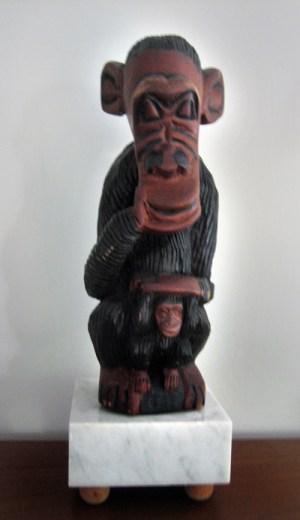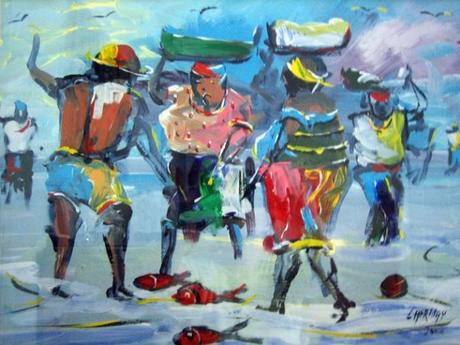
Beauty is in the eye of the beholder
While living in Ghana, West Africa, an American friend and I decided to study the contemporary art scene in Accra, the capital. Now, before you read this story, let me warn you: I don’t know anything about art, so if you do, please skip this story. It might be better for your blood pressure. Or, on the other hand, if art bores you, go watch TV.
About this monkey carving:
We found it among possessions that had been in storage for years and we have no idea where it came from, or who might have given it to us. It makes a great doorstop.
On not being a culture aficionado(a):
Just in case you think my expat life here in Ghana was shallow and empty and all I did was play goddess in the kitchen and write romance novels, let me assure you that once in a while I did get the itch to do something cultural. Go to African drumming performances. Attend a Ghanaian play put on at the Bywel Bar. Act in a play. Gaze at paintings and ponder art. That sort of thing.

Finding Culture
My mate and I even played Daisy the Cow in a stage play put on by The International Players. See the photo? I’m the front end of Daisy. My man’s the back end. (Allow me to point out that the prop person who created Daisy was not a famous artist.)
Love art, love life
Art is everywhere in Ghana — it blossoms on fabrics, shop signs, billboards, and public service posters….

However, in this story my friend Jan and I will focus on paintings in art galleries. So come with us as we begin our exploration by visiting a large art center downtown. The main sales room is hot and poorly lit and we are the only visitors. The person in charge is a woman of generous girth taking a nap with her head on the desk, exhausted from boredom, we suspect. Ghanaians have the amazing ability to sleep in public places, such as by the side of the road with decrepit trucks thundering by belching diesel fumes three feet from their faces. I admire such intrepidity.
The Louvre it is not
There are many paintings in this muggy room, carelessly stacked in corners, irreverently piled in portfolios and crookedly displayed on walls, suspended by what looks like fishing line.
The sleeping beauty wakes up when she hears us move around the room. Instantly infused with energy, she comes barreling toward us, eyes full of purpose. “The price is on the back,” she declares, yanking around the painting we are discussing. Indeed, the price is on the back.
“Thank you,” Jan says nicely. “We’d like to look at the front first.”
She hovers while we move on. “The price is on the back!” she states firmly when we pay special attention to a particular piece.
The phone rings and she trundles over to her desk to answer it and we continue our perusal of the paintings. Her phone conversation terminated, our friend comes rushing toward us once again. She practically shoves us aside, grabs the painting we’re looking at and jerks it around to show us the price. “There, you see it?”
Yes, we see it. I smile at her. “We’d like to look at the front first,” I say. Perhaps it didn’t register the first time. Fortunately, a man arrives, demanding her attention, and she’s off again.
The Yellow Splasher
In the mean time we discover an interesting artist with an annoying habit. He does appealing work and then ruins it by taking a brush of sun-yellow paint and giving a swift whack in the direction of the canvas thereby decorating his creation with blobs and streaks of yellow. That’s what it looks like he’s done, anyway. The first time you look at one of his paintings you like it, but it’s too bad about that yellow blob in the middle. Then you see several more and you groan, oh no, the Yellow Splasher again, and after a while you feel like running from the room screaming. No more yellow blobs please!
“The price is on the back!” comes the voice of madame, sitting at the table shuffling papers.
We ignore her.

Another day, another gallery
We’re in a residential house jam-packed with art work. We look at paintings of jolly market women, muscled fishermen, wild drummers, dizzy dancers and Bedouin horsemen in flapping robes tearing out of the desert.
The place is not air-conditioned and sweat drips down my back and chest. I can barely breathe. Sometimes you suffer when you do culture, but onward we go, to one more little gallery. One more, we tell ourselves, before we have lunch in a cool place.
No suit and tie
We’re greeted by a freaky-looking young guy in shorts and T-shirt, his black skin generously dusted with white powder, as if he’s ready for a pagan dance ritual. Or maybe it’s a celebratory thing; I’ve heard of that. Or maybe he has a rash.
He scratches his chest vigorously while he discourses with us about art, and the fact that he only represents artists he likes, such as Victor Odoi. We like his work too: impressionistic market scenes, fishing scenes, village scenes, alive with great colors and joy and energy.
For days on end Jan and I scour the town for new galleries, new artists, new treasures. Each time we go home feeling dizzy, not to speak of ditzy. We are obsessed.
The Pinhead Painter
During another one of our art safaris we find ourselves looking at the paintings of Kofi Agorsor in one of the better-known galleries. This is day five of our art quest. Or is it six? We’re beginning to lose track.
“He hates women,” Jan says. “You can just tell.”
Agorsor is famous. Expatriates love his work, shell out big prices for it and have it hanging in their living rooms. They must not see what Jan sees. I take a step back, assume a studious expression and look.
The paintings are very contemporary, flat, cartoonish works in bright colors, mostly depicting African women with weirdly contorted bodies — huge rear ends, enormous boobs, one thin arm and one thick arm, and always with long skinny necks and minuscule heads with little scarves tied on. Tiny heads everywhere. Kofi Agorsor flunked anatomy class.
“Don’t tell me,” Jan says, “that this guy has a high opinion of women, the way he portrays them.”
So, forget him and his pinheads, is what I say. Give me a Victor Odoi. He has no such problem. He likes women, especially market women, and he paints them with happiness and skill and normal heads. So, if you want advice about Ghanaian art from somebody who knows nothing, go get yourself a Victor Odoi or a Ricson Agyare or a Seth Clottey. Do bring your money, because a couple of tens won’t do it. It’s not art sold by the roadside, you know.
There’s some of that too,
if that tickles your fancy. You can get paintings of Bob Marley, Elvis, Jesus, the Holy Father. Big ones, to fill a whole wall and stare at you while you eat your bran flakes in the morning.
And of course the requisite psychedelic coconut-beach-sunset scenes done especially for tourists are available by the road as well, along with the paintings of big-bottomed African mamas with huge loads of vegetables on their heads and babies on their backs, all rendered in garish colors that will light up your room without benefit of electricity.
But again, I am not knowledgeable about art, so I don’t want to judge. Find what you like by the road or online by googling. But do read on, because . . .
You won’t believe what happens next
One Saturday morning I take the love of my life to a couple of galleries to check out if we agree on some of my finds. One gallery, the one of the itchy owner, has kept aside a couple of smaller Victor Odoi creations for me – a fish market scene, and a beach scene with boats. My mate has a thing for fishing boats, so I am hopeful we’ll find us something to hang on our wall.
He does not love these Odoi paintings. He doesn’t mind them, but they don’t speak to him, do not stir his soul. Unbelievable. Do I not know this man? I watch him as he glances around.
“I like that one,” he says, pointing.
It’s one of the pinhead paintings.
***
Note: You must have noticed if you googled Kofi Agorsor that he has pinhead paintings of men too: fishermen and jazz musicians. He is quoted as saying that he loves women and loves their company. So there you have it. Check out more of Kofi Agorsor’s work
* * *
QUESTION: Do you have any fun stories about art you have bought or artists you have met during your foreign travels? Hit that comment button!

